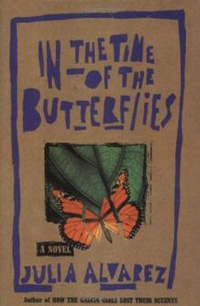
Book Club
Julia Alvarez
Tuesday, May 2, 2017
Synopsis
It is November 25, 1960, and three beautiful sisters have been found near their wrecked Jeep at the bottom of a 150-foot cliff on the north coast of the Dominican Republic. The official state newspaper reports their deaths as accidental. It does not mention that a fourth sister lives. Nor does it explain that the sisters were among the leading opponents of Gen. Rafael Leonidas Trujillo’s dictatorship. It doesn’t have to. Everybody knows of Las Mariposas―“The Butterflies.”
In this extraordinary novel, the voices of all four sisters―Minerva, Patria, María Teresa, and the survivor, Dedé―speak across the decades to tell their own stories, from hair ribbons and secret crushes to gunrunning and prison torture, and to describe the everyday horrors of life under Trujillo’s rule. Through the art and magic of Julia Alvarez’s imagination, the martyred Butterflies live again in this novel of courage and love, and the human cost of political oppression.
(From the publisher.)
Reading Group Discussion Questions
- Although she does not reveal the details, Alvarez lets us know from the start that the novel will end tragically. Why do you think she made this choice?
- How do the sisters differ in personality, goals and self-expression? How does Alvarez dramatize these differences?
- How does the Trujillo regime portray itself? What means does it use to build a positive public image?
- How does this police state control its citizens? How do its methods develop over the course of the novel?
- What kinds of violence are directed against women both politically and socially? How do these forms of violence connect to the experiences of the men?
- What events radicalize each sister? What personal commitments and feelings complicate the commitment to political activism for them?
- What groups or institutions offer significant support or resistance to Trujillo both within and beyond the borders of the Dominican Republic?
- This novel has been called polyphonic in that it contains many voices rather than a single narrator’s. How many voices and kinds of writing can you track as you read? How do these multiple voices connect with the themes of the novel?
- This novel can also be seen as an example of resistance literature. How does Alvarez’s choice of subject and Dede’s later life as the keeper of her sisters’ history become a form of opposition to tyranny?
- Readers of this novel have connected Maria Teresa’s sections with The Diary of Anne Frank. How do the content and form of these two works express similar themes and approaches to writing?
- Alvarez brings in many legends and sayings from traditional Dominican culture. What values do these sayings express?
- Dreams play an important role in the novel. What are some of the dreams and how do they relate to reality?
- The anacahuita tree and the moon are recurring images in the novel. When do they appear and how do they contribute to the narrative?
- How did you react to the intensity of suffering and pain in the novel? What kept you reading? Has the experience influenced you to do more reading or to take any sort of action?
- In the face of the kind of brutality that the novel documents, do art and storytelling have any real power or social value?
(Questions issued by the Chicago Public Library as part of the city’s One Book program.)
Additional Book Club Resources
Other Works by Julia Alvarez
Fiction
How the García Girls Lost Their Accents (1991)
In the Time of the Butterflies (1994)
Yo!.(1997)
In the Name of Salomé (2000)
Saving the World: A Novel (2006)
Poetry
The Other Side (El Otro Lado) (1995)
Homecoming: New and Selected Poems (1996)
The Woman I Kept to Myself (2004; 2011)
Nonfiction
Something to Declare (1998)
Once Upon a Quinceañera: Coming of Age in the USA (2007
A Wedding in Haiti: The Story of a Friendship (2012)
If You Liked In The Time of the Butterflies, may we recommend …
Dreaming in Cuban, Cristina García
The House on the Lagoon, Rosario Ferré
So Far from God, Ana Castillo
Caramelo, Sandra Cisneros
The Hummingbird’s Daughter, Luis Alberto Urrea
The Feast of the Goat, Mario Vargas Llosa
Of Love and Shadows, Isabel Allende
When I Was Puerto Rican, Esmeralda Santiago
The Farming of Bones, Edwidge Danticat
Down These Mean Streets, Piri Thomas

